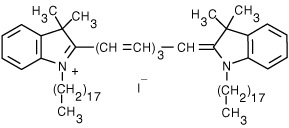All AbMole products are for research use only, cannot be used for human consumption.

DiR is a long-chain carbocyanine dye. Carbocyanine dyes are widely used as Di to label cells, organelles, liposomes, viruses and lipoproteins.

Nat Commun. 2025 Jan 03;16(1):262.
Inhalable nanovesicles loaded with a STING agonist enhance CAR-T cell activity against solid tumors in the lung
DiR iodide purchased from AbMole

Biomaterials. 2025 Jan 21;318:123117.
Anaerobic probiotics-in situ Se nanoradiosensitizers selectively anchor to tumor with immuno-regulations for robust cancer radio-immunotherapy
DiR iodide purchased from AbMole

Journal of Food Biochemistry. 2025 Apr 11.
Curcumin‐Loaded Mesenchymal Stem Cell‐Derived Exosomes: A Potential Effective Strategy for NAFLD
DiR iodide purchased from AbMole

Bioact Mater. 2024 Mar 20;37:132-15.
Immune-defensive microspheres promote regeneration of the nucleus pulposus by targeted entrapment of the inflammatory cascade during intervertebral disc degeneration
DiR iodide purchased from AbMole

ACS Nano. 2024 Dec 21.
Biomimetic “Trojan Horse” Fibers Modulate Innate Immunity Cascades for Nerve Regeneration
DiR iodide purchased from AbMole

ACS Nano. 2023 Sep 12;17(17):16770-16786.
Sequential Targeting Hybrid Nanovesicles Composed of Chimeric Antigen Receptor T-Cell-Derived Exosomes and Liposomes for Enhanced Cancer Immunochemotherapy
DiR iodide purchased from AbMole

J Transl Med. 2023 Jun 12;21(1):383.
Inhalable CAR-T cell-derived exosomes as paclitaxel carriers for treating lung cancer
DiR iodide purchased from AbMole

Biomater Sci. 2022 Sep 13;10(18):5187-5196.
Delivery of enzalutamide via nanoparticles for effectively inhibiting prostate cancer progression
DiR iodide purchased from AbMole

J Nanobiotechnology. 2021 Nov 25;19(1):391.
Nanovesicles derived from bispecific CAR-T cells targeting the spike protein of SARS-CoV-2 for treating COVID-19
DiR iodide purchased from AbMole
| Molecular Weight | 1013.39 |
| Formula | C63H101IN2 |
| CAS Number | 100068-60-8 |
| Solubility (25°C) | DMSO 5mM |
| Storage | -20°C, protect from light, dry, sealed |
[4] Hao Liu, et al. In vivo Near-infrared Fluorescence Tumor Imaging Using DiR-loaded Nanocarriers
| Related Fluorescent Dye Products |
|---|
| DSPE-Rhodamine
DSPE-Rhodamine is formed by the conjugation of DSPE with the Rhodamine fluorescent dye. DSPE possesses a hydrophobic lipid tail and a hydrophilic head group, while Rhodamine is a red fluorescent dye. DSPE-Rhodamine retains the lipid properties of DSPE while also imparting fluorescent labelling capabilities. As a key component of delivery systems, DSPE-Rhodamine enhances targeting and bioavailability. Its lipid properties facilitate the penetration of molecules through cell membranes, while its fluorescent properties enable tracking of distribution and dynamic changes within the body. |
| LD540
LD540 is a novel high-sensitivity lipophilic dye modified with BODIPY fluorescent groups, designed for precise labelling and imaging of lipid droplets. LD540 exhibits excellent photostability and an optimal fluorescence spectrum, making it compatible with various commonly used fluorescent dyes (such as DAPI and Alexa Fluor 647), thereby supporting multi-colour imaging requirements. Additionally, LD540 is suitable for both fixed and live cells and can label ultra-small lipid droplets. |
| PDMPO
PDMPO (Yellow/Blue DND-160) is a ratiometric probe for the determination of lysosomal pH for fluorescence imaging. PDMPO exhibits pH-dependent dual excitation and dual emission peaks. PDMPO produces blue fluorescence (Ex/Em=329 nm/440 nm) in weakly acidic organelles, and in more acidic lysosomes it becomes yellow fluorescence (Ex/Em=384 nm/540 nm). |
| Copper probe CF4
Copper probe CF4 (Copper fluor CF4) is a Cu+-specific fluorescent probe based on a rhodol dye scaffold. Copper probe CF4 (Copper fluor CF4) has high copper selectivity with a Kd value of 2.9×10-13 M, particularly over zinc and iron, as well as abundant cellular alkali and alkaline earth metals. Copper probe CF4 (Copper fluor CF4) is stable in a physiologically relevant pH regime between 6 and 8 (wavelengths of 415 nm for excitation and 660 nm for emission). Copper probe CF4 (Copper fluor CF4) can be used to study colon cancer. |
| Phalloidin-Fluor 647 Conjugate
Phalloidin-Fluor 647 Conjugate selectively binds to F-actins. Used at nanomolar concentrations, phalloidin derivatives are convenient probes for labeling, identifying and quantitating F-actins in formaldehyde-fixed and permeabilized tissue sections, cell cultures or cell-free experiments. |
All AbMole products are for research use only, cannot be used for human consumption or veterinary use. We do not provide products or services to individuals. Please comply with the intended use and do not use AbMole products for any other purpose.


Products are for research use only. Not for human use. We do not sell to patients.
© Copyright 2010-2024 AbMole BioScience. All Rights Reserved.
